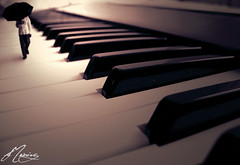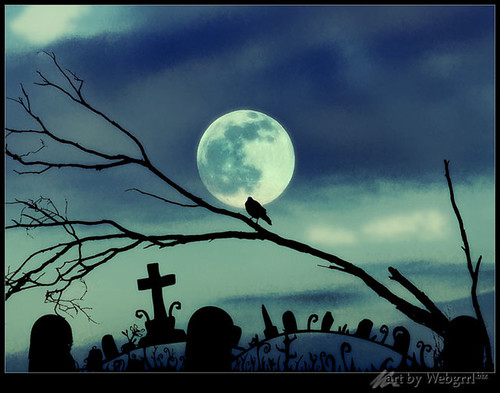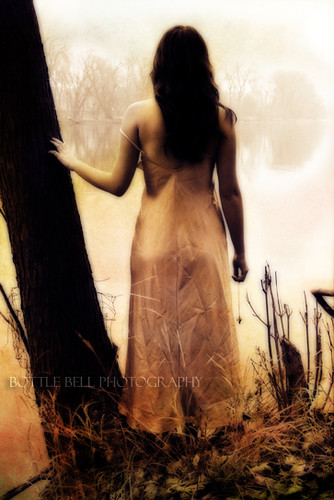Extroverted 4s and melancholy 7s. Yes, they do exist. A classic Myers-Briggs type that can fall in as either a 4w3 or a 7w6 is the ENFP. While most 7 Myers-Briggs equivalents are characterized as pragmatic realists, and most 4 equivalents are characterized as sensitive idealists, the ENFP "Visionary" is characterized as both a doer and a dreamer. Among other categories, they can easily fall into the 7w6 category or the 4w3 category.
 | Martin Short 7w6 ENFP Canadian-American comedian, actor, writer, singer and producer. Interviews "You are thrilling tonight..." |  | Gwen Stefani 4w3 sx/so ENFP American singer, songwriter, fashion designer, and occasional actress |
 | Robin Williams 7w6 ENFP American actor and comedian. Interviews "I think, atleast you get a good laugh..." |  | Haley Williams 4w3 ENFP Lead vocals of American pop rock band Paramore. |
 | Carol Burnett 7w6 ENFP Actress, comedian, singer, dancer and writer. Pieces "The specials for me all started..." |  | Christopher Sarantakos "Criss Angel" 4w3 ENFP. American magician, musician, escapologist, stunt performer, and actor. |
 Thinking vs. Feeling Centers
Thinking vs. Feeling CentersOne of the differences that we can see between ENFP 7s and ENFP 4s is that the 7 is a Head type while the 4 is a Feeling type. The 7 may have an element of nervous energy to them, and the 4 may have an element of subtle self-conciousness to them.
According to Understanding the Enneagram, 7s are out of touch with their feeling centers. This does not mean that they cannot feel, indeed, average 7s can be touched. They just tend not to stay with that feeling for long. This is because their Thinking Center is used to directly motivate their Moving-Instinctual Center. In other words, if at any time their level of mental activity begins to receed, they start to feel a kind of depravity within themselves, and automatically run into something stimulating. Think--Do.
Fours can look similar because they also need to be constantly stimulated to keep themselves happy. They also rely on the stimulation of the Thinking Center, but instead of this rushing directly to the Moving-Instinctive Center, it becomes a burning furnace of imagination for the Feeling Center. Fours do things primarily because of the way that it will make them feel, because they need constant intense feelings to sustain their inner sense of self. As soon as they stop feeling intensity in the Feeling Center, they start to feel a loss of self, so they may quickly look for something to stimulate the imagination and pleasure centers.
Because of this difference in core needs--stimulation vs. identity--the 7's search will look more like gluttony and the 4's more like indulgence. This is because the 7 cheifly needs the brain stimulated, not the heart, while the 4 lives for intense emotion.
 The Two-Faced ENFP
The Two-Faced ENFPENFPs, in particular can be difficult to type between 7s and other types, if they are indeed not 7s. (6w7s actually seems to be the most common type for ENFPs, followed by 7w6s, 9s and 9-wingers, 2w3s, and 4w3s.) Part of the difference is explained on Personalitypathways.com:
- ENFP Type Faces:
Introverted Extraverted
F . . . . . . . . . S . . . . . . . . .
N . . . . . . . . .T . . . . . . . . .
Feeling.Type Paradoxes - An I/ENFP example
Let's look at the other primary I/ENFP face (SF). The SF pattern suggests a persona more consistent with the "traits" frequently ascribed to ENFPs - the warm, fun and people loving side of their personality who can very much live in and enjoy the moment. INFPs more typically keep the SF face hidden, yet it provides the energy for their participation in helping professions, all kinds of nurturing activities, and their interest in performing arts and arts and crafts work in general.
I/ENFPs who have developed both their NT and SF faces can present a capricious image of contradictions. They can engage in logical dialogue at a conceptual level (NT) and then a short time later engage in actions that seem to fly in the face of that discussion (because their SF nature was engaged). Extraverts seem to be particularly adept at turning either of these faces to the outer world - depending on the circumstances. At one moment, being able to talk and make the big picture, tough decisions and at another moment be warm, fuzzy, or empathetic are two sides of the same NFP coin. Yet this can be disquieting - conjuring up the image of false masks implied by the pejorative term "two-faced."
 Escaping from Pain
Escaping from PainSome might characterize 4s as only succumbing and wallowing in painful feelings and depression. But trying to flee from painful feelings is actually characteristic of a 4 with a strong wing, whether a 3 or a 5 wing. They try to escape in pleasurable, exciting, indulgent, emotional, or fantasy experiences. With a sexual variant this will cause them to get involved with exciting, intense, intimate relationships and experiences. With a 3 wing their usual extroversion will cause them to focus on these experiences in the outer world. With a strong 5 wing disintegrating, their 7-ness will show in an impulsive accumulation of stimuli and experiences. They can even be very stubborn about being obligated to do anything they don't particularly feel like doing, avoiding any restraint or responsibility. The element of the 3 can also make them afraid of commitment, since secretly the 3 doesn't want to be exposed in intimacy (specifically a sexual instinctual variant 3).
Some 4s think that they must be 7s because they do not have room in their concept of a 4w3 for a pain-avoiding extrovert, which many 4s with a strong wing will find themselves being.
Some 4w3s may feel that because they have strong self-confidence and the need to pull themselves up when they feel bad that they cannot be 4s. But the real concern is with the core fixations of the types, not just the behaviors. But a healthy 4w3 can be very self-confident and desiring to pull themselves out of painful feelings. They are extroverted and incredibly assertive. When healthy they are also positive and action-oriented, always on the move. Other people may even feel threatened by their own sense of personal power. These differences from a how a 4 is typically viewed is why they have been the hardest types to fit in the 4 box. 3w4s are actually quite similar to the 4w3 in these ways. They have the 4ish core issues, but are very pick-themselves-up-and-go and, especially at healthy levels, couldn't see themselves as even able to manifest the depressive self-loathing of the 4s.
 Romanticism vs. Realism
Romanticism vs. RealismThe thing that can be the most misleading is the way that 4s tend to view their similarity with 7s, their romantic obsession with what a pain-avoiding extrovert must be. But the thing is, real 7s are not as romantic as they might like to think. In fact, a 7 in real life may be quite dissappointing to a 4.
Everything Riso and Hudson claims about 7s is true. Their is little idealized fantasy in them. There is very fleeting focus on fantasy, compared to a 4's. This is using the term "focus" with more of the connotations of enduring longevity than the connotations of simple "attention," meaning that they can have intense interest for a designated time, and that stimulus intensifies their stimulated energy, but only for a time, followed by sudden disinterest. Only at their very most healthy can they concentrate on a fantasy intensely and long like a 4 can. And still, there is a more detached element and they do not need it to become a part of them and determine or sustain their identity, like a 4 needs. Emotions and idealized fantasy does not sustain them, so they cannot be refueled by it like a 4 does and keep going with it. Rather it is the pure element of mental stimulation that sustains them. That is the chief difference between a real 7 and a real 4, the stimulation-focus vs. the pleasure and escape focus. And yes, there is a difference. There is a much less immersive act of the 7, they are not immersing their whole soul like a 4 does. They say, "Oh! This is awesome! This is great," and then one disappointment and they completely loose interest for that moment, and, as one 7-winger, put it "life s*cks" for that moment. They have absolutely no interest, no fantasy lingering, like a 4. This is the general look of them, compared to the general look of a 4.
Think, for one moment, about Robin Williams. Is the person in question at all like Robin Williams? Even Jim Carrey? And it is true that 7s like Jim Carrey can have "emotional," sentimental, even deep moments. We've seen his convincing more serious acting in movies like Eternal Sunshine, and it is convincing, because it is obviously a part of him that he can bring out. But 7s, once looked at extensively, could never be mistaken for 4s, although more extroverted 4s have a problem seeing this when they read the disembodied descriptions of 7s.
Escapism is not a quality of 7s like it is for 4s. There can be much, much fleeing from pain, into idealized romanticism, in a way that 4s would like to think is like a 7's.
Actually, the only 4s who are so bound by their depression may be 4s without a dominant wing. Because one's with a strong 5 wing will eventually use stimulation like 7s to constantly distract them from their problems. They may never be able to let their brains be "quiet" or they will start to get panicky and start to feel pain, so may, like some 5s, look for anything to distract themselfs. For 4w5s it may be books, video games, puzzles, systems of thought like personality theory, always longing for the idealized experience. And "longing" like 4s to is completely different from 7s. 7s energy as centered on one thing lasts like a short-lived candy high compared to a 4s', as Riso and Hudson suggest.
4w3s may as well distract themselves from pain by dwelling on and involving themselves in exciting outward experiences and relationships, always longing for a better one. A 4s social variant can also cause them to be very scattered, high-octane, acting very dorky and silly, like some think a 7 would.
 Seeking Identity vs. Stimulation
Seeking Identity vs. StimulationThe core need of the 4 and the core need of the 7 are very different, and, when viewed closely, do produce very recognizable differences. The problem with the way that a 4w3 may misidentify themselves as 7s is because of their desire for escapism and their extroverted energetic-ness. But the definition of a 7 is not escapism and energetic-ness. It is pure mental stimulation that is their core need, completely unlike a 4's, which is identity. This causes them to manifest different kinds of energy, different kinds of humor. That's why only a very healthy 7 can be so focused, and when someone is that healthy, you'll know, because they are so put-together.
The characteristic of a doubting 4w3 contemplating and even arguing their identity can provide some signal that they are really a 4. 4s without a 3 wing may tend to accept their true type right away, being already aware of the core need within themselves. But for the 4w3, because the 3 is out of touch with their feeling center, may have more problems identifying this in himself, perhaps also because he doesn't not want to view himself as having those fixations, viewing it as a weakness or something that will detract from his image of his own desired identity. On the other hand, it is doubtful that a true 7 would spend as much time as a 4w3 can defending, developing, and defining their identities.
According to Rachel Baron and Elizabeth Wagele, the more common Myers-Briggs equivalents of the 7 are characterized by being pragmatic realists, most of them Sensing types. While the common equivalents of the 4 are characterized, in general, by emotional depth and idealism, most of them NFs. That's a very recognizable difference. Many 4w3s could never be described as characteristically pragmatic realists, far from it. Perhaps active idealists, but that's that. So if an ENFP is a 7, they will also have a close connection to the other Myers-Briggs equivalents for it. Correctly typed people often have a strong connection to the other Myers-Briggs equivalents of their type, including the equivalents of their wing type. But interestingly, never to all of the equivalents of their trifixes, which may be saying something.
But those who argue that a certain type is not the way Riso and Hudson puts it simply because THEY are that way, and these psychologists must therefor be wrong, in my opinion, to be taken seriously, must have equal backing as the psychologists do to back them up. Otherwise, they may need to take them a little more seriously. It is important to respect the work for the study which you are studying, if you are to truly benefit from it. It is important, that if you intend to refute it, that you fully understand their academic research, all of their reasons behind it, to accurately be able to wrestle with the material. "Well, I am not like that," doesn't mean necessarily that they are wrong. Many times when people say they disagreed with them, they actually misinterpreted or misplaced what they were actually saying, or truncated the message.
What these descriptions are about is the core need of the type, not just all the behaviors produced by it. And it is easy to confuse yourself as to what the real need is, deep down inside you, because we like to have a certain image of ourselves. Of several people who were recently introduced to the Enneagram and counseled, all of those who were thinking types or instinctual types seemed to embrace their type quickly. It was only the types 3 and 4 who had a particular trouble embracing their type, constantly trying to divert the attention to behavioral patterns that seemed to fit another type, a type they obviously secretly wanted to be seen as being. This is nothing to look down on them for, however. It is just simply behavior related to their core needs, identity and image, the way they are seen and the way they see themselves, so they seek the way that brings them the most mental satisfaction, even unbeknownst to themselves. And who can blame them for seeking to satisfy their core inner need, one that, if they let themselves be fully aware of it, would dissatisfy that need, because suddenly they are not the version of themselves that they desire to be? Only after years of hard learning can some 4s admit something similar to themselves, opening themselves up to become particularly sensitive, concerned, and sympathetic towards the needs of themselves and of others.
 Feeling Types
Feeling TypesYes, there are NF 7s as well as NF 4s, known as "Feeling" types in the Myers-Briggs personality study. According to Renee Baron & Elizabeth Wagele, ENFPs are one of the more common types of both 4s and 7s, so they may find some confusion in typing themselves.
When an NF feels identity-issues, which produce behaviors like longing for intense, ideal experience and draws the feeling out, they are a 4 type. The only thing innately 4ish about the ENFP is the inferior, less used, Introverted Sensing function, which can produce a strong sentimentality for past experiences. It says nothing about romanticized, desired future experiences, like a 4's fixation produces. So this characteristic would likely be something related to their core fixation, and not simply the quality of being NF>
 Extroversion
Extroversion4s without a 3 wing may well be subtle, understated personalities, tending towards being withdrawn and introverted. However, the 3 wing causes the 4 to want to stand out a little, often causing marked extroversion and assertiveness, and a boost in the 4's regularly low seratonin levels (see Scientific Proof for the Enneagram.). If the withdrawn 4 is subtle mauve and the assertive 3 is bright yellow, then the 4w3 is electric purple! (Or, hehe, death-black and blood-red, if that's better befitting of the nature of their identity fixation.)
Social 4s of both wings, as well, may be incredibly goofy and expressive like what seems like 7 characteristics, but still have all the fantasy-fixations of the 4. They may even related to 7s very much in their relationships, both liking to go out and experience fun things, but they are very different when it comes to prolonged interested in an idealized emotion or fantasy.
Some fours, indeed may feel a lack of energy from being in the world - often like they are being drained, so they retreat within. But this is also a very 4w5 thing. A more extroverted 4w3, for instance, may feel energized by intense (possibly idealized) experiences in the world. It is dangerous to associate a type's essential characteristics by things that aren't dependent on its core need. Your particular wing, variant, or level of health may cause you to experience things in ways that people of the same type but different variations may experience quite differently.
Some may say that the 4w5 "burns brighter" than the 4w3. But, when you really think about it, the 4W3 may very well "burn longer and with more vigor". This can be very true of sexual or social 4w3s. They can be very charming and sparkley, alot of people being attracted to their friendship and charisma. They may concentrate very briefly and intensely on one person at a time, and then excitedly moved to another, very intense, very silly, crazy, scattered-seeming, even.
 Envy
EnvyEnvy is supposed to be a characteristic behavior for 4s, but many 4s may not be aware of it, or even manifest it in the sense of the traditional meaning of the word "envy." So they might think that they must be sevens because of what they see as a lack of "envy" of other people. But actually, the term "envy," as used by Riso and Hudson, could be simply longing to be something that they are not, the "envy," in the sense, of the ideal. Because the type 3 is out of touch with its feeling center, and thinks that the image it constructs and projects for itself is itself, the 4w3 is someone affected by this. They may not even realize that they are the way they are because they want that image. Riso and Hudson use the word "envy" almost as a kind of term as the desire to be something other than yourself, in a way that actually makes you change your own internal identity. Only when 3s become healthy are they concerned with real authenticity in their image, and only when 4s become healthy can they accept and feel their true inner identity, unsustained by any external symbols, labels, or characterizations.
 Behavior vs. Core Fixation
Behavior vs. Core FixationThe Enneagram tries to layout the behavior of each type as it is in general, then tries to talk about how the type is at different levels of health, with different wings, and with different instinctual variants. So, with that taken into account, you may fitting the description of a 4w3, augmented by the 5 wing, the sexual/self-preservation variants, and varying levels of health. Each of these augments the descriptions of the 4, and pulls out things that would apply more to you because of your unique secondary characteristics, while points out other things that would fit you less, due to the same characteristics, all created by the same core fixation.
The main observable difference between 4s and 7s is in the 4's emotional longing vs. the 7's energized but shallow interest:
"Fours...cherishing beautiful objects of the sake of their beauty and the feelings that beauty awakens in them. A stone picked up on the beach or a twig with a single bud can quicken their aesthetic feelings and satisfy them. By contrast, while average Sevens want to possess beautiful objects, they become increasingly unappreciative and insensitive to the beauty or value of those objects. They become acquisitive not because they enjoy things for themselves but because the acquisition of possessions provides a sense of security. And even more fundamentally, what excites Sevens is the stimulation they feel when they desire something new. The stimulation of their appetites reinforces their sense of self, although once they have actually acquired what they want, they usually lose interest in the acquisition. The pair of shoes that they were "dying" to have join the racks with a dozen so others; the fur coat they were drooling over for weeks suddenly becomes "that old thing" as they turn their attention to acquiring something else." - Riso and Hudson, Understanding the Enneagram, "Misidentifications" section.
As Riso and Hudson also said at the beginning of Understanding the Enneagram, no one manifests all of the behaviors of one type, so it is not even expected that you would fit every description of the 4 or the 7, just the core ones. The 4 will experience a real appreciation of beauty (in things, fantasy, emotions, etc.) vs. the 7's fleeting materialistic interest. This is the core difference between me 4s and 7s, because most 7s you meet will only be average health and will show this problem.
Because of this essential difference, a 4w3 may be able to see that that their claims to 7 and their problems with the 4 are explainable by variations of the 4, while their problems with the 7 are not explainable by variations of the 7. This deep, intense, prolonged "longing" connected to a fascination with fantasy ideals, like a theme in their life, is not explainable by any of the variations of the 7--wings, variants, or states of health. Because they feel so close to both 7 and 4 characterizations, because they do this, their core inner focus is more on identity than stimulation. The same thing could be said, incidentally, to a 4 trying to figure out whether they are a 4 or a 5, as 5s have many 7-seeming issues.
At the end of the day, the thing that truly makes a 4, according to R&H, is the desire to be true to oneself. This fixation is the direct result of the core need of identity. 7s and 7-wingers may indeed be NFs, a characteristic which has nothing innately to do with identity issues. They don't have the issues around the desire of being yourself and being understood like 4s do. 7s and 4s just have different fixations. All the NF does, the extroverted intuition and introverted feelings of the ENFP, more common to both types, is makes them notice threads of meaning and scan for what could be, and makes them have an internal sense of the "essence" of a person or a project, reading them with fine distinctions among feeling-tones. The NF quality does not induce the development of identity needs. Being a 4 does.
 Sexual 7s vs. 4s
Sexual 7s vs. 4sIt may be said that a sexual variant in any type makes them seem more 4-like, with more idealism and feelings of longing and fantasy. But sexual 7s will still display all the characteristics of shallow disinterest with a thing they were just a minute ago so happy about, everything R&H has said about them was still true for them. Even my super-creative and even melancholy-seeming observed 7 could be taken for a 4 in the sense that he is melancholy, but when you really look at him you see that he has the same problem with a prolonged appreciation of beauty. For an observed 7w6 it was found that, although he can get interested for periods of time and create wonderful works of art, he quickly gets this depressive sigh about it, and is utterly uninterested, an astoundingly sudden and complete change.
If you compare the core problem of the 7 to the core problem of the 4, they will always be able to tell eachother apart. An observed 7-winger is a classic example as well, a 6w7 who seemed incredibly grave and melancholy many times, many of the outer qualities which you might think of as 4 qualities, but he has the same core problems as the 7-wing as described so importantly in the Misidentifications section. And as much a 4s may identify with the observed 7-winger so well in their depth in other areas, in this area he really does have problems. He has the 7ish problems with prolonged appreciation of the beauty of one thing. He'd fool you because he always talks about his sentimental appreciation of systems or people in his life that keep him secure, as he is an NF, but when it comes to being able to be engaged and appreciate something entertaining, he becomes 7ish. Quickly utterly and shallowly disappointed, this kind of shutter and sigh comes out of him, that it's just old now. It's so fascinating to observe Michael Scott from The Office, and watched him have incredibly similar reactions. When you watch Michael get incredibly excited and then, like, oh this s*cks, that is characteristic of average 7s, although exaggerated and he's probably exceptionally unhealthy.
 7s and Shallow Disinterest
7s and Shallow DisinterestSome people may take offense to the characterization of the 7 as "more shallow" than the 4. But the differences aren't really that superficial. 7s can be deep or creative, like the observed 7 and 7-winger. Like said in the misidenfications area though, there are certain instances where problems with focus exist, and it is, like R&H said, an important distinction. And, 4s, being around creative 7s, as much as they might feel connection to them, when it comes to the same obsession they have over amplifying and drawing out idealistic, intense feelings and experiences, the 7s do not join in with them. To this, the 7s may feel more "shallow" to the fours, because their interest in things is not able to be idealized and romanticized in such a prolonged passion as the 4 has for it. They just have different core needs, as R&H pointed out, so they are fueled by different things, and therefore pursue and experience the same source of enjoyment differently. In the end, an average's 7s focus may be characterized by intial intense excitement, followed by a sudden and utter shallow disillusionment and disinterest. It as if it has suddenly become old to them.
Let's take one 7w6 who has been observed for many years. He's pretty healthy, and has integrated to 5 somewhat, because he can learn anything just about seemingly instantly, though at times you can see him disintegrating. Life is all about present stimulus for him. He gets interested in computers, he spends alot of money buying the latest one on the market, spends a deal of time on it, then completely looses interest. There is almost a pessimism he views his computer with now. While others were fascinated by it, and he seemed kind of disappointed just by looking at it. "Oh yeah, that old thing," he seemed to say, with depressive frustration.
He got interested in piano as a child, became an excellent pianist. Can play anything just by looking at it. He created an self-made album. Now he looks at the piano with the same depressive frustration.
He became interested in painting around the time his father died, spent several months painting from scratch. Became an excellent painter seemingly instantly. But now he looks at it with boredom when you mention it, almost as if saying, "Well, THAT doesn't stimulate me any more."
He bought an excellent house a few years ago. Was really excited, decorating, taking care of the pool, getting involved in the community. Now he seems to take it all for granted. Kind of lays around and sighs until you mention something that might interest him, and gets incredibly excited.
That horrible boss Michael Scott on the American version of "The Office" was typed as a 7w6. I did a research project on him for one of my senior projects, recording his behavior as he did it, and I was amazed at how many of those same depressive looks of frustration he gave to things after seeming so excited about them perhaps only a minute ago. Very good acting; I think that character is a part of him, somehow. The observed 6w7 is also frequently caught giving those same looks to things that once brought him stimulation. It is like a spoiled child with a broken toy. Utter shallow, disappointed disinterest.
 7s vs. 4s in Melancholy, Depth, and Creative Expression
7s vs. 4s in Melancholy, Depth, and Creative Expression7s who entertain like Robin Williams and Jim Carrey are not the only forms of 7. The observed 7w6 seven described earlier is incredibly creative and talented, and not as much the over the top entertainer, possibly due to his sexual variant. But he still faces all the issues of focus and detachment Riso and Hudson describe, as are also described earlier. This characteristic of more integrated 7s does not detract from their characteristic problems with focus, which are only more visible when they are in average to unhealthy levels.
The 7s' creativity can definitely be characterized with a different terminology than 4s. When a healthy 7 becomes focused, it is still with a more realistic and pragmatic sense than a 4, not being energized by the idealistic and fantasy aspects so much as the purely stimulative ones. This is an important difference, as it shows itself even more when 7s disintegrate and loose their ability to stay with the stimulus. Even the Myers-Briggs common 7 equivalents tend to be more action-oriented, realistic, pragmatic entertainers and quick-witted innovators. Realism in art is a little different, but it may be able to serve as a pattern.
Leonardo DaVinci has been typed as a 7 integrated to 5, a man who become an expert seemingly quickly at anything he picked up, able to focus intently on things for a time. But, if he is typed correctly, there would also be more of a realistic, pragmatic element to his focus, compared to an integrated 4. And there is seen in his work an extreme element of realism and focus on the smallest detail. The problem is, since none of us can know Leonardo, none of us can correctly tell what he was like at all times. A person existing in real life can be observed, though. The observed 7 was used as an example because, perhaps like Leonardo, he had integrated to 5 at periods of his life, and produced wonderful works of art and music for the time that he was stimulated by them. It was also observable, though, that as he disintegrated, he became easily beset by a sudden and shallow disinterest, as described earlier. It was not fantasy or emotions that stimulated him, even now, but the novelty and intricacy of the details associated with a thing.
That's why the 7 integrates to 5, perhaps, since type 5s are characterized as detached, analytical observers. But the part that makes the integrated 7 five-ish is that their normal capacity to become stimulated by a new source is a now focused and intense observation, like a 5's. Much of a 4w5's relation to a 7 is obviously through their 5 wing. They see themselves being like integrated 7s in that they are able to absorb information and become an expert in many areas, and that when disintegrated they are like scattered, stimuli-hungry 7s. But the main difference is that the 4, even with a 5 wing, is characterized more by longing for an ideal, intense experience, and then sustaining that experience, fixating on it for long periods of time and reliving it, to sustain that fantasy, and then going out and seeking more. This pleasure, fantasy, and idealism focus is quite different from the real focus overall for 7s. The average 7--repeat, the average 7--is mentally inwardly saying, almost, "okay, I don't care, gimme stimulation. aw, it's old already. grrr. let's move on. okay, gimme more. aw, now it's stupid. moving on..."
 4w3s Seeking Image Subconsciously
4w3s Seeking Image SubconsciouslyType Three is characterized by Riso and Hudson as adaptive, excelling, driven, and image-conscious, traits which affect the psychological build of the identity-seeking 4w3. The 4w3 is driven to maintain the image of their identity. If they are fun-loving, they want people to regard them as that. The main problem observed with 4w3s becoming aware of this is that they are pursuing this goal of image is subconsciously. If they allowed themselves to see that they are not the carefree extrovert they regard themself to be, that they are regaled by identity and image issues, then their ego collapses into a depressive state. Because of this, average to unhealthy 4w3s can be seen as more brittle and yes, even psychologically more fragile, than the 4W5. The 4's usual fear of being "found out" for their essential flawed-ness is experienced beneath the level of awareness, with much potentially detrimental consequences.
Often, instead of letting this happen, they simply experience the pain from an unknown subconcious source. Once becoming aware of and trying to confront this source, the 4w3 may find themself trying to grasp at the source of their pain, and coming up with blanks. A classic scene is of one sitting all alone in the middle of the moonlight woods, staring off into nothing, knowing they had to confront something, but not knowing what. And somehow, even if a person knew exactly what to say to them, it would be almost impossible to say, because it would break their heart. It could easily bring the searching 4w3 into that depressive, nihilistic void that says "you are not who you say you are, even to yourself, and all is lost," because they were not ready for it, to experience that kind of pain and humility that would bring them to self-knowledge. The 4w3 may not be able to rise out of the resulting depression at having been "found out." It is so subconcious, even to themselves, that it can be a very dangerous admission to approach.
 The Search for Self and Nihilism
The Search for Self and NihilismA 4 or a 4-winger trying to place themselves in the Enneagram personality study, or within any system, may feel confining, and that it augments or constricts their identity. They may simply give up and say that they are just not definable, falling in between several different types. But the Enneagram is actually less confining than they may feel, allowing for many different variations of personality. And if the core fixation is understood, that is all that matters.
5s and 5-wingers may also feel the overwhelming amount of dissenting possibilities leading them to disillusionment with the system itself, a kind of nihilism the 5 wrestles with. But actually, there IS objective findable truth in the Enneagram, or in any sound personality theory. The Enneagram does not claim to delineate every single thing about a person's psyche, but it's more accurate than some people beset by some form of nihilism would like to acknowledge. The thing about the Enneagram is that it's not just tests that find it for you. It's spiritual practice and practice that leads to self-awareness. That's where subjectivity comes in, of course, but with empathetic and knowledgeable professionals to help you in person, even psychological progress can involve an element of objective standards of health. Someone asking questions of a person or their own understanding of things does not determine that the system itself is essentially flawed, inaccurate, or incompetent. Only without nihilism can further open-minded, open-hearted study of the system determine its validity. Belief in meaninglessness, that nothing can be determined, is an inaccurate belief, leading one, not to open-mindedness, but to ineffective observation, that tosses out gathered evidence when the problems seem too muddled to determine an objective analysis. Being presented with a plethora of information may induce nihilism, but allowing oneself to succumb to it only disempowers your essential powers of analysis.


4 comments:
what if you don't have a wing?
i'm a 4w3
most likely...
I must say, I'm shocked to see no comments on this amazing post.
I'm an ENFP 4/5w male dating an ENFP 7/6w female. The points and observations about the difference in core needs is spot on - I am in it for the potential of a sustained amazing emotional connection, and she for the exciting newness and intellectual stimulation.
Time will tell if we can renew her core need for new exciting mental stimulation and i can accept and live with the fact that her core need is not for sustained emotional connection.
great post and observation!
I must say, I'm shocked to see no comments on this amazing post.
I'm an ENFP 4/5w male dating an ENFP 7/6w female. The points and observations about the difference in core needs is spot on - I am in it for the potential of a sustained amazing emotional connection, and she for the exciting newness and intellectual stimulation.
good read
Post a Comment